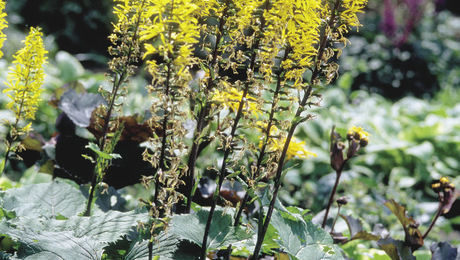



best fragrant perennials
midwest
regional picks
‘Pink Spike’ bugbane
name: Actaea simplex ‘Pink Spike’
usda hardiness zones: 4 to 8
size: 4 feet tall and 2 feet wide
conditions: Partial to full shade; moist soil
If you’re in search of the Holy Grail of dark-foliage plants, bugbane should never be overlooked. The cultivar ‘Pink Spike’ emerges in early spring with astilbe-like, dark bronze-purple foliage that serves as a perfect foil for large-leaved, shade-loving perennials. With adequate moisture, the foliage remains clean and unblemished throughout the summer doldrums. Then in autumn, when most shade-dwelling perennials look tired and slug-riddled, ‘Pink Spike’ sends up an array of dark purple stems topped with pale pink bottlebrush flowers. And just to be sure that the elegant bloom is noticed, it emits a sweet fragrance that will stop you dead in your tracks.
‘Sorcerer’ peony
name: Paeonia lactiflora ‘Sorcerer’
zones: 3 to 8
size: 3 feet tall and 2 feet wide
conditions: Full sun; well-drained soil
Requiring little or no effort on the part of the gardener, peonies consistently provide an abundance of blooms every summer. ‘Sorcerer’ peony is one of the best varieties. A vigorous grower, its dark red petals surround a rich golden center. Although its sweet fragrance is not as brash as many double-blossomed peonies, it is bold enough to have perfect strangers stop and comment on the scent as they walk past my garden. More important, when other multipetaled peonies are bowing over from early-summer storms, ‘Sorcerer’ stays erect on strong stems, and it seldom (if ever) requires any support.
‘Blue Moon’ woodland phlox
name: Phlox divaricata ‘Blue Moon’
zones: 3 to 8
size: 1 foot tall and 3 feet wide
conditions: Partial shade; moist, well-drained soil
Underappreciated and underused, ‘Blue Moon’ woodland phlox has lush green foliage that emerges in early spring. After the last spring bulb has withered, this phlox becomes blanketed with deep blue-violet flowers, which last for up to three weeks. The fragrance of its blooms signals a source of nectar to early native insects and butterflies. This hardy and compact plant is a prolific ground cover, spreading by underground roots. From my original plant, I have transplanted half a dozen pieces to other shady areas, where they have happily flourished. Shear it back after flowering is complete to tidy up its appearance.
‘Hyperion’ daylily
name: Hemerocallis ‘Hyperion’
zones: 3 to 8
size: 40 inches tall and 2 feet wide
conditions: Full sun to partial shade; well-drained soil
‘Hyperion’ daylily has been around for almost 90 years, but sadly, many gardeners still aren’t familiar with it. It has 5-inch-wide, lemon yellow blooms with a small green throat that perch atop tall scapes. You can expect what most other daylilies offer: vigorous growth, tolerance of less-than-ideal soil conditions, a long bloom season, a resistance to pests, and minimal fuss from the gardener. But unlike the other daylily cultivars, ‘Hyperion’ has a strong, sweet fragrance that will reward your attention when it blooms in early summer. You’ll never settle for ‘Stella de Oro’ daylily (Hemerocallis ‘Stella de Oro’, Zones 3–8) again once you experience the glorious fragrance of ‘Hyperion’.
Janice Becker is a volunteer at the Chicago Botanic Garden, when she’s not pulling weeds in her own garden in Deerfield, Illinois.
Photos, except where noted: millettephotomedia.com; #2, Bob Gutowski/courtesy of commons.wikimedia.org; #4, Doreen Wynja; bottom right, courtesy of Janice Becker

















Comments
Log in or create an account to post a comment.
Sign up Log in